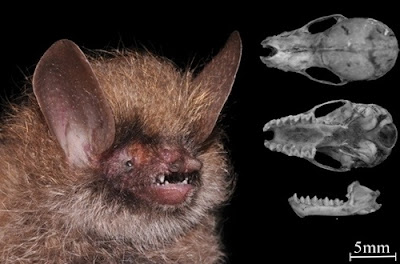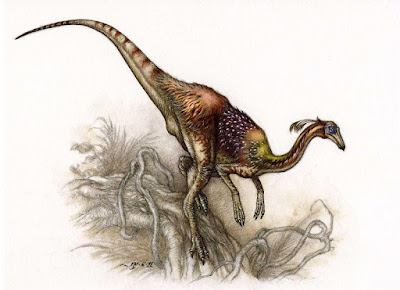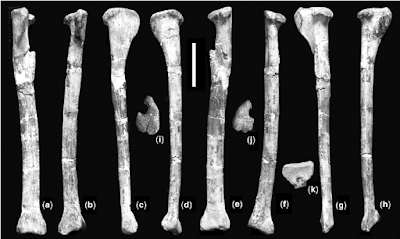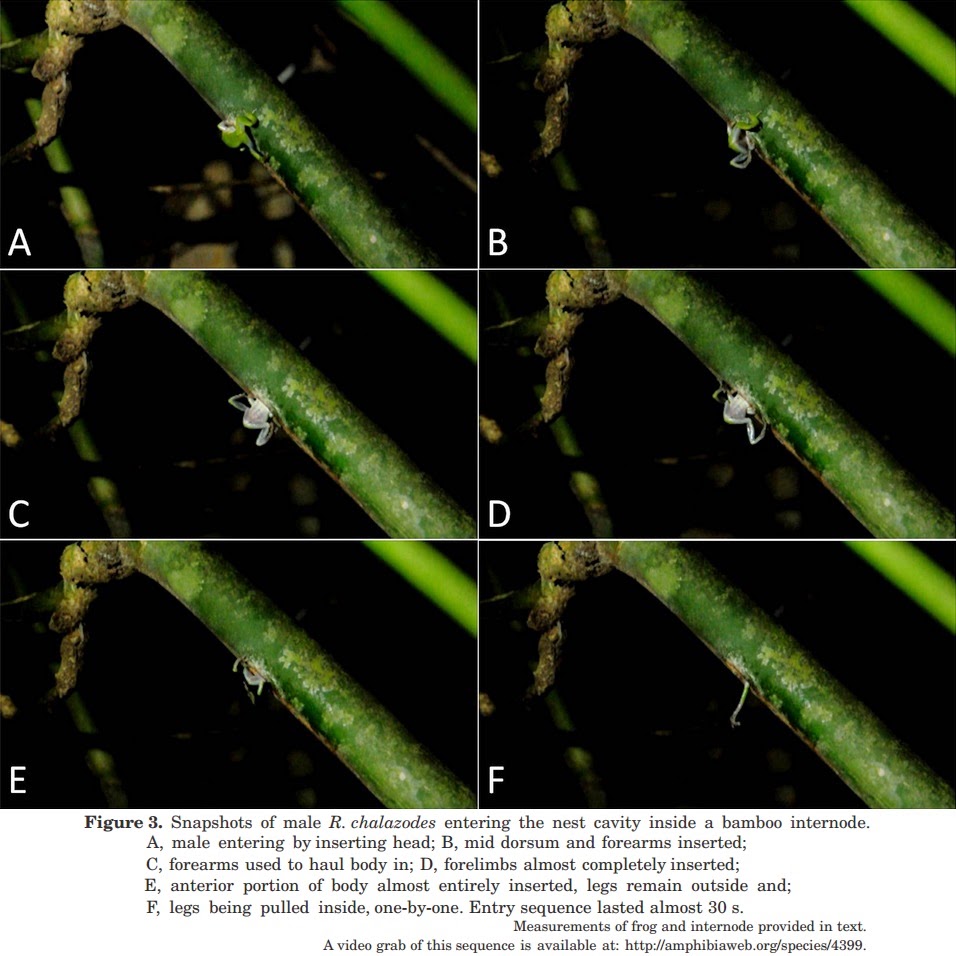![]() |
Cryptomyrus ogoouensis & C. ona
Sullivan, Lavoue & Hopkins, 2016 |
Abstract
We use mitochondrial and nuclear sequence data to show that three weakly electric mormyrid fish specimens collected at three widely separated localities in Gabon, Africa over a 13-year period represent an unrecognized lineage within the subfamily Mormyrinae and determine its phylogenetic position with respect to other taxa. We describe these three specimens as a new genus containing two new species. Cryptomyrus, new genus, is readily distinguished from all other mormyrid genera by a combination of features of squamation, morphometrics, and dental attributes.Cryptomyrus ogoouensis, new species, is differentiated from its single congener,Cryptomyrus ona, new species, by the possession of an anal-fin origin located well in advance of the dorsal fin, a narrow caudal peduncle and caudal-fin lobes nearly as long as the peduncle. In C. ona, the anal-fin origin is located only slightly in advance of the dorsal fin, the caudal peduncle is deep and the caudal-fin lobes considerably shorter than the peduncle. Continued discovery of new taxa within the “Lower Guinea Clade” of Mormyridae highlights the incompleteness of our knowledge of fish diversity in West-Central Africa. We present a revised key to the mormyrid genera of Lower Guinea.
Keywords: Weakly electric fish, Mormyrinae, integrative taxonomy, phylogeny, DNA, electric organ discharge, EOD, African freshwater fishes, rarity
![]() |
Figure 1. Geographic location of collection sites for the three mormyrid specimens treated in this study. Red star = type locality of Cryptomyrus ogoouensis sp. n. at Doumé, Ogooué River; green star = type locality of Cryptomyrus ona sp. n. at the Moukalaba River; green circle = locality of second specimen of C. ona at the Mabounié River.
|
![]() |
Figure 2. Photographs of the collection localities of the three mormyrid specimens treated in this study. A Doumé falls on the Ogooué River, Ogooué-Lolo, Gabon, type locality of Cryptomyrus ogoouensis sp. n. during high water in May 2011 B same locality in low water, September 2014 C Nyanga River at confluence with Moukalaba River near collection site of holotype of Cryptomyrus ona sp. n., July 2001 D Collection site of Cryptomyrus ona specimen CUMV 98647 in Mabounié River, Ngounié Province, February 2012.
|
Taxonomy
Cryptomyrus gen. n.
Type species: Cryptomyrus ogoouensis sp. n.
Included species: Cryptomyrus ogoouensis sp. n., Cryptomyrus ona sp. n.
Diagnosis:
Cryptomyrus gen. n. is distinguished from all other mormyrid genera by combination of the following features. Scales large: 44 or 45 along the midlateral line, with about 42 pierced lateral line scales; mouth subinferior; broad but nonprotrusive chin swelling that does not extend beyond snout; snout expansive and rounded in lateral profile with slight inflection point visible above anterior margin of eye in lateral view; snout somewhat v-shaped in dorsal view; eye large, 19–20% HL; middle four teeth on dentary squarish, broad and spatulate, oriented nearly horizontally, central two lower teeth longest along inner edges and in contact with each other, jutting in advance of neighboring pair and forming a trowel-like shape (Fig. 6); ventral profile of head with marked concavity between gular region and chin, body depth increasing rapidly from there to pelvic-fin origin, body depth at pelvic-fin origin 21–24% SL; interorbital width 32–35% HL; dorsal-fin length 78–88% of anal-fin length; caudal-peduncle depth at end of anal fin greater than 30% of caudal-peduncle length; faint, wide and diffuse band of pigment between anterior portion of dorsal fin and anal-fin bases, darkest from midlateral region dorsally.
Etymology: Gender masculine; from the Greek kryptos meaning secret or hidden referring to the rarity of these fishes in collections and the Greek myros, a kind of fish, a suffix used in the names of many other mormyrid genera.
![]() |
Figure 5. Maximum likelihood phylogenetic tree calculated in RAxML for 46 mormyrin specimens based on DNA sequences from mitochondrial cytochrome b, 12S, 16S and nuclear rag2 and S7 intron, rooted with Myomyrus macrops. Bootstrap support values at nodes. Some clades collapsed for simplicity. Position of new taxa (magenta) within the “Lower Guinea Clade” (green) and distance from Hippopotamyrus castor, type species of genus Hippopotamyrus (red), highlighted.
|
Cryptomyrus ogoouensis sp. n.
![]() |
Figure 7. Holotype of Cryptomyrus ogoouensis CUMV 98155, female, 112 mm SL, Ogooué River at Doumé falls, Ogooué-Lolo Province, Gabon. Left and right views of preserved whole specimen and radiograph shown below photo of specimen immediately post-mortem.
|
Diagnosis: Cryptomyrus ogoouensis sp. n. is readily differentiated from its sole congener, C. ona sp. n., in the possession of an anal-fin origin located well in advance of the dorsal fin (first dorsal ray above anal-fin ray 7 vs. first dorsal ray above anal-fin ray 3), a narrow caudal peduncle (depth 5.1% SL vs. 6.0–6.8% SL), and lobes of caudal fin nearly as long as caudal peduncle (vs. markedly shorter).
Etymology: The specific epithet is a Latinized noun in the genitive case and refers to the Ogooué River of Gabon.
Distribution and ecology: Currently known only from the Ogooué River at Doumé falls. At the collection site, we recorded a water temperature of 26.7 °C, a pH of 6.89, water conductivity of 13.8 μS/cm and dissolved oxygen of 84.7%.
Cryptomyrus ona sp. n.
Diagnosis: Cryptomyrus ona sp. n. is readily differentiated from its sole congener, C. ogoouensis sp. n., in having an anal-fin origin located only just in advance of the dorsal fin (first dorsal ray above anal-fin ray 3 vs. first dorsal-fin ray above anal-fin ray 7), a deep caudal peduncle (6.0–6.8% SL vs. 5.1% SL), and lobes of caudal fin markedly shorter than caudal peduncle (vs. nearly as long as peduncle).
Etymology: The specific epithet is a noun in apposition that honors Marc Ona Essangui, Gabonese environmental and civic activist, founder and executive director of the NGO Brainforest and recipient of the 2009 Goldman Environmental Prize, in appreciation for his efforts to protect Gabon’s equatorial forests and wetlands.
Distribution and ecology: Known from the type locality in the Moukalaba River at its confluence with the Nyanga River. A second specimen referred to this species comes from the Mabounié River, a small right-bank affluent of the lower Ngounié River, below Samba Falls. Both specimens were caught by gill net at night. At the type locality we recorded water temperature of 23.6 °C, pH of 8.0, water conductivity of 116.0 μS/cm and dissolved oxygen of 4.98 mg/l. Water conductivity at the Mabounié River at time of collection of that specimen was 48 μS/cm.
John P. Sullivan, Sebastien Lavoue and Carl D. Hopkins. 2016.
Cryptomyrus: A New Genus of Mormyridae (Teleostei, Osteoglossomorpha) with Two New Species from Gabon, West-Central Africa.
ZooKeys. 561: 117-150. DOI:
10.3897/zookeys.561.7137
Résumé
Nous avons démontré avec des marqueurs mitochondriaux et nucléaires que trois spécimens de poissons mormyridés faiblement électriques, collectés à trois localités au Gabon sur une période de 13 ans, forment une lignée inconnue au sein de la sous famille des Mormyrinae dont nous avons déterminé la position phylogénétique. Nous décrivons un nouveau genre et deux nouvelles espèces pour ces trois spécimens.Cryptomyrus, nouveau genre, se distingue des autres genres de mormyridés par une combinaison de caractères de l’écaillure, morphométriques, et dentaires. Cryptomyrus ogoouensis, nouvelle espèce, se distingue de sa seule espèce congénérique par sa nageoire anale qui commence nettement en avant de sa nageoire dorsale, son pédoncule caudal gracile et les lobes de sa nageoire caudale pratiquement aussi longs que son pédoncule caudal. Chez Cryptomyrus ona, nouvelle espèce, la nageoire anale commence légèrement en avant de l’origine de la nageoire dorsale, le pédoncule caudal est large, et les lobes de la nageoire caudale sont plus courts que le pédoncule caudal. La découverte ininterrompue de nouveaux taxa dans le «clade de basse Guinée» des Mormyridae illustre notre connaissance incomplète de la diversité des poissons de l’ouest de l’Afrique centrale. Nous présentons une clé révisée des genres de Mormyridae de basse Guinée.
![]()
![]()































































